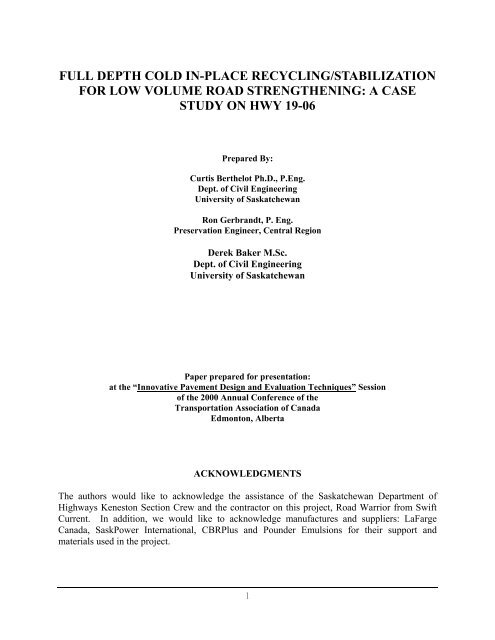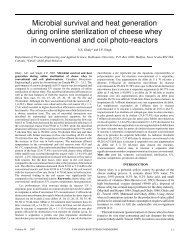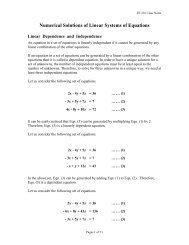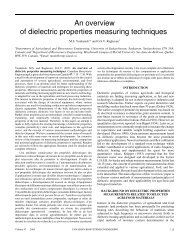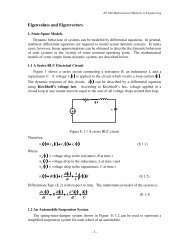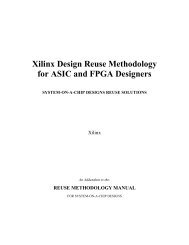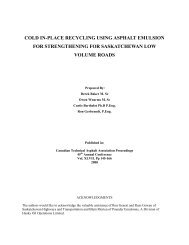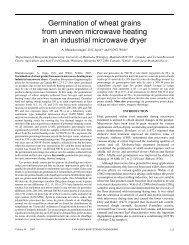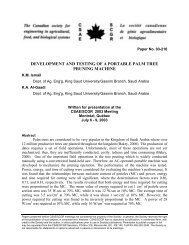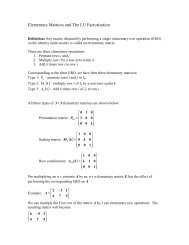Full Depth Cold-in-Place Recycling/Stabilization for Low Volume ...
Full Depth Cold-in-Place Recycling/Stabilization for Low Volume ...
Full Depth Cold-in-Place Recycling/Stabilization for Low Volume ...
You also want an ePaper? Increase the reach of your titles
YUMPU automatically turns print PDFs into web optimized ePapers that Google loves.
FULL DEPTH COLD IN-PLACE RECYCLING/STABILIZATION<br />
FOR LOW VOLUME ROAD STRENGTHENING: A CASE<br />
STUDY ON HWY 19-06<br />
Prepared By:<br />
Curtis Berthelot Ph.D., P.Eng.<br />
Dept. of Civil Eng<strong>in</strong>eer<strong>in</strong>g<br />
University of Saskatchewan<br />
Ron Gerbrandt, P. Eng.<br />
Preservation Eng<strong>in</strong>eer, Central Region<br />
Derek Baker M.Sc.<br />
Dept. of Civil Eng<strong>in</strong>eer<strong>in</strong>g<br />
University of Saskatchewan<br />
Paper prepared <strong>for</strong> presentation:<br />
at the “Innovative Pavement Design and Evaluation Techniques” Session<br />
of the 2000 Annual Conference of the<br />
Transportation Association of Canada<br />
Edmonton, Alberta<br />
ACKNOWLEDGMENTS<br />
The authors would like to acknowledge the assistance of the Saskatchewan Department of<br />
Highways Keneston Section Crew and the contractor on this project, Road Warrior from Swift<br />
Current. In addition, we would like to acknowledge manufactures and suppliers: LaFarge<br />
Canada, SaskPower International, CBRPlus and Pounder Emulsions <strong>for</strong> their support and<br />
materials used <strong>in</strong> the project.<br />
1
ABSTRACT<br />
Gra<strong>in</strong> transportation rationalization, economic diversification and value added <strong>in</strong>itiatives with<strong>in</strong><br />
the Saskatchewan economy has <strong>in</strong>creased commercial truck traffic on many Saskatchewan roads<br />
and will cont<strong>in</strong>ue to do so <strong>in</strong> the <strong>for</strong>eseeable future. These <strong>in</strong>creases <strong>in</strong> commercial truck traffic<br />
hold significant and often-immediate implications <strong>for</strong> Saskatchewan secondary roads (roads<br />
traditionally with ESALs of between 100 and 1000) because many of these roads were not<br />
designed to accommodate significant numbers of heavily loaded commercial trucks. Of<br />
particular concern, is the approximately 8600 km of th<strong>in</strong> membrane surfaced (TMS) roads of<br />
which many are experienc<strong>in</strong>g accelerated and at times, catastrophic damage. TMS roads are of<br />
particular concern because they are expensive to repair once surface breaks occur and TMS<br />
roads can be particularly sensitive to truck load<strong>in</strong>g when subgrades are thaw-weakened. As a<br />
result, <strong>in</strong>creas<strong>in</strong>g commercial truck traffic has translated <strong>in</strong>to a clear need to strengthen many<br />
Saskatchewan TMS and other secondary highways.<br />
Although preserv<strong>in</strong>g the Saskatchewan secondary road network us<strong>in</strong>g conventional methods is<br />
both technically feasible and economically tenable <strong>in</strong> some situations, conventional methods are<br />
not economically feasible <strong>for</strong> many low volume roads <strong>in</strong> the time frame required to provide an<br />
susta<strong>in</strong>able level of service that serves the immediate needs of the commercial road transport<br />
<strong>in</strong>dustry across the entire secondary road network. As a result, alternative and <strong>in</strong>novative road<br />
strengthen<strong>in</strong>g solutions are required. This paper presents the technical and economic case study<br />
of pilot test sections constructed by the Preservation and Operations Branch of Saskatchewan<br />
Highways and Transportation to evaluate alternative full-depth cold <strong>in</strong>-place recycl<strong>in</strong>g and<br />
strengthen<strong>in</strong>g techniques on Control Section 19-06.<br />
2
1.0 BACKGROUND<br />
The Saskatchewan road <strong>in</strong>frastructure is comprised of approximately 198,700 kilometers of two lane<br />
equivalent roads with an estimated capital asset value of seven billion dollars (SHT, 1996). A primary<br />
function of the Saskatchewan road <strong>in</strong>frastructure is to facilitate the assembly and export of bulk<br />
resources such as gra<strong>in</strong>, timber, petroleum, build<strong>in</strong>g products, and m<strong>in</strong>ed m<strong>in</strong>erals. S<strong>in</strong>ce the export<br />
of bulk resources comprises two thirds of Saskatchewan’s gross domestic product, efficient road<br />
transportation has a direct and profound impact on the Saskatchewan economy. Gra<strong>in</strong> transportation<br />
rationalization and economic diversification <strong>in</strong>clud<strong>in</strong>g value-added <strong>in</strong>itiatives with<strong>in</strong> the<br />
Saskatchewan economy has significantly <strong>in</strong>creased commercial truck traffic on many Saskatchewan<br />
roads.<br />
1.1 Pressures on Saskatchewan Highway Network<br />
Given the significant capital asset value of the Saskatchewan road network and the direct l<strong>in</strong>k roads<br />
have to the Saskatchewan economy, preserv<strong>in</strong>g Saskatchewan roads while promot<strong>in</strong>g transportation<br />
efficiency is of paramount importance to Saskatchewan. Chang<strong>in</strong>g transportation policies <strong>in</strong> recent<br />
years has <strong>in</strong>creased commercial truck<strong>in</strong>g on many Saskatchewan roads by orders of magnitude.<br />
Policy changes such as removal of the Crow Rate <strong>for</strong> the transportation of export gra<strong>in</strong>, which<br />
resulted <strong>in</strong> rationalization of the prov<strong>in</strong>cial gra<strong>in</strong> transportation system. In particular, rail companies<br />
abandoned branch l<strong>in</strong>es and elevator companies replaced thousands of country gra<strong>in</strong> elevators along<br />
rail branch l<strong>in</strong>es with a mere handful of large <strong>in</strong>land term<strong>in</strong>als along the rail ma<strong>in</strong>l<strong>in</strong>es. As a result,<br />
farm to market delivery of gra<strong>in</strong> has shifted from multiple short trips <strong>in</strong> two and three axle farm trucks<br />
to larger, more efficient commercial trucks.<br />
In addition, the government of Saskatchewan has encouraged both diversification and value<br />
added activities with<strong>in</strong> the Saskatchewan economy, particularly rural Saskatchewan. Examples<br />
<strong>in</strong>clude the development of the prov<strong>in</strong>ce’s oil and gas reserves, expansion of the hog <strong>in</strong>dustry,<br />
and development of the prov<strong>in</strong>ce’s m<strong>in</strong><strong>in</strong>g sector. The comb<strong>in</strong>ed impact of gra<strong>in</strong> transportation<br />
rationalization and proactive economic diversification has <strong>in</strong>creased road transport tonnekilometers<br />
by orders of magnitude on many Saskatchewan roads, as well as encouraged the use<br />
of larger more cost-effective commercial trucks as shown <strong>in</strong> Figure 1.<br />
While these changes <strong>in</strong> Saskatchewan’s commercial truck<strong>in</strong>g profile have long-term implications<br />
<strong>for</strong> the primary highway system, these major routes are designed to accommodate significant<br />
volumes of heavily loaded trucks and there<strong>for</strong>e experience only marg<strong>in</strong>al <strong>in</strong>creases <strong>in</strong><br />
preservation costs over their design lives. However, these <strong>in</strong>creases <strong>in</strong> commercial truck traffic<br />
hold significant and often-immediate implications <strong>for</strong> many Saskatchewan secondary roads, of<br />
which many were not <strong>in</strong>itially designed or constructed to accommodate significant numbers of<br />
heavily loaded commercial vehicles. As a result, <strong>in</strong>creas<strong>in</strong>g commercial truck traffic has<br />
translated <strong>in</strong>to the need to strengthen many Saskatchewan secondary roads. Of particular<br />
concern is the approximately 8600 km of Saskatchewan non-structural th<strong>in</strong> membrane surface<br />
(TMS) roads of which many are experienc<strong>in</strong>g accelerated damage. TMS roads are of particular<br />
concern because they are expensive to repair once surface breaks occur and these types of roads<br />
are particularly sensitive to truck load<strong>in</strong>g when subgrades are thaw-weakened.<br />
3
1.2 Th<strong>in</strong> Membrane Surface Roads<br />
Figure 1: 9-Axle Tra<strong>in</strong> Gra<strong>in</strong> Truck<br />
Over the past several decades Saskatchewan Highways and Transportation designed and<br />
constructed approximately 8600 km of th<strong>in</strong> membrane surface roadways. TMS roads were a<br />
relatively <strong>in</strong>expensive method of provid<strong>in</strong>g oil treated surfaces <strong>for</strong> low volume roads.<br />
20 to 40mm ASPHALTIC MIX<br />
GRAVEL SHOULDER<br />
SUBGRADE<br />
THIN MEMBRANE SURFACE<br />
STRUCTURAL PAVEMENT<br />
80 TO 130mm ASPHALT CONCRETE<br />
SHOULDER VARIES FROM<br />
45mm ASPHALT CONCRETE TO GRAVEL<br />
150 TO 200mm BASE<br />
150 TO 450mm SUB-BASE<br />
SUBGRADE<br />
Figure 2: Comparison between Th<strong>in</strong> Membrane Surface and a Structural Pavement<br />
TMS roads were not <strong>in</strong>tended to provide added structural capacity, but were a cost effective<br />
means to provide dust, mud, and stone free roads to local rural residents where truck traffic was<br />
m<strong>in</strong>imal (ESAL’s
effective and an easily ma<strong>in</strong>ta<strong>in</strong>able road surface. However, <strong>in</strong> recent years, <strong>in</strong>creased truck<br />
traffic associated with chang<strong>in</strong>g road transportation policies, Saskatchewan TMS roads have<br />
experienced considerable <strong>in</strong>creased haul pressure result<strong>in</strong>g <strong>in</strong> extensive damage to much of the<br />
TMS system.<br />
1.3 Conventional Preservation of Th<strong>in</strong> Membrane Surface Roads<br />
Conventional TMS preservation/management solutions currently employed by Saskatchewan<br />
Highways and Transportation (SHT) <strong>in</strong>clude:<br />
‣ Ma<strong>in</strong>ta<strong>in</strong> exist<strong>in</strong>g TMS roads <strong>in</strong> spite of <strong>in</strong>creas<strong>in</strong>g ma<strong>in</strong>tenance costs.<br />
‣ Make the capital <strong>in</strong>vestment required to upgrade TMS roads to paved structural roads.<br />
‣ Revert TMS roads to gravel surfaced roads.<br />
‣ Regulate and/or restrict commercial traffic and/or limit truck weights.<br />
‣ Enter <strong>in</strong>to partnerships with local Rural Municipalities to have commercial trucks operate on<br />
the RM gravel system <strong>in</strong>stead of the TMS system.<br />
‣ Enter <strong>in</strong>to partnership haul agreements with commercial carriers whom employ road friendly<br />
vehicle technologies such as central tire <strong>in</strong>flation and air-spr<strong>in</strong>g suspension systems.<br />
‣ Implement some comb<strong>in</strong>ation of a) through f).<br />
Although preserv<strong>in</strong>g the Saskatchewan TMS road network us<strong>in</strong>g conventional methods is<br />
tenable <strong>in</strong> some situations, conventional methods are not economically feasible <strong>in</strong> the time frame<br />
required to provide an adequate and susta<strong>in</strong>able level of service across the entire TMS road<br />
network.<br />
1.4 <strong>Cold</strong> In-<strong>Place</strong> Recycl<strong>in</strong>g Road Strengthen<strong>in</strong>g Alternatives<br />
Given the pressures fac<strong>in</strong>g Saskatchewan’s secondary road network, new <strong>in</strong>novative TMS road<br />
strengthen<strong>in</strong>g solutions are required <strong>for</strong> a significant portion of the TMS road network. Recent<br />
advances <strong>in</strong> stabilization eng<strong>in</strong>eer<strong>in</strong>g and <strong>in</strong>-place recycl<strong>in</strong>g construction techniques can<br />
potentially provide several advantages <strong>for</strong> manag<strong>in</strong>g the TMS road network us<strong>in</strong>g a “build<br />
down” approach. Several full depth stabilization systems are currently available on the market,<br />
<strong>in</strong>clud<strong>in</strong>g granular soil, cement, lime, flyash, geotextiles, natural and manufactured fibers,<br />
emulsified bitumen, tall oil, lign<strong>in</strong>, foamed bitumen and synthetic ionic chemicals. However,<br />
there is considerable uncerta<strong>in</strong>ty associated with these stabilized road systems because of their<br />
<strong>in</strong>herent complex physiochemical and micro mechanical behavior. The high degree of<br />
uncerta<strong>in</strong>ty is primarily related to the fact that, until very recently, only phenomenological<br />
laboratory tests and/or experience based methods have been available <strong>for</strong> the design,<br />
specification, quality control/quality assurance, and per<strong>for</strong>mance prediction of stabilized road<br />
systems. These traditional phenomenological-empirical methods are limited because they are, <strong>in</strong><br />
effect, trial and error methods. As a result, public road agencies have been reluctant to use<br />
stabilization <strong>in</strong> anyth<strong>in</strong>g other than small trial applications, even though the potential economic<br />
and environmental benefits of stabilized road systems can be quite compell<strong>in</strong>g.<br />
Recent developments <strong>in</strong> thermomechanistic and physiochemical characterization and<br />
mechanistic model<strong>in</strong>g of roads have the potential to overcome the limited predictive capabilities<br />
5
associated with traditional phenomenological-empirical methods and provide road eng<strong>in</strong>eers<br />
with a rational framework to defensibly evaluate stabilized road systems. A mechanistic<br />
framework will reduce the uncerta<strong>in</strong>ty associated with the per<strong>for</strong>mance of stabilized road<br />
systems <strong>in</strong> diverse applications.<br />
2.0 HIGHWAY 19-06 COLD IN-PLACE RECYLING/STRENGTHENING PILOT<br />
PROJECT<br />
2.1 Goal and Objectives of Highway 19-06 Pilot Project<br />
Given recent <strong>in</strong>creases <strong>in</strong> commercial truck traffic, SHT needs to research and implement<br />
alternative preservation/strengthen<strong>in</strong>g procedures <strong>in</strong> order to provide a timely and susta<strong>in</strong>able<br />
level of service on many Saskatchewan TMS roads. Although conventional TMS preservation<br />
strategies are effective <strong>in</strong> most situations, it is apparent there will be significant benefits<br />
associated with more cost-effective ways to strengthen exist<strong>in</strong>g TMS roads, <strong>in</strong>creas<strong>in</strong>g their load<br />
carry<strong>in</strong>g capacity and reduc<strong>in</strong>g their moisture and freeze/thaw sensitivity. As a result,<br />
Saskatchewan Highways and Transportation are <strong>in</strong>vestigat<strong>in</strong>g cold <strong>in</strong>-place recycl<strong>in</strong>g (CIR) as<br />
an alternative TMS preservation treatment.<br />
The Highway No. 19 project <strong>in</strong>volved SHT, the University of Saskatchewan and three materials<br />
suppliers; Lafarge Canada, SaskPower International and CBRPlus-Pounder Emulsions. The<br />
overall goal of the project was to evaluate and implement more cost-effective and efficient<br />
strengthen<strong>in</strong>g methods <strong>for</strong> low volume th<strong>in</strong> membrane surfaces. Each participant has <strong>in</strong>dividual<br />
goals and objectives:<br />
‣ Saskatchewan Highways and Transportation<br />
• Provide more cost-effective road strengthen<strong>in</strong>g solutions <strong>for</strong> Saskatchewan taxpayers.<br />
‣ The University of Saskatchewan<br />
• To develop and prove out a mechanistic based eng<strong>in</strong>eer<strong>in</strong>g framework to evaluate,<br />
specify and control <strong>in</strong>-place recycl<strong>in</strong>g and strengthen<strong>in</strong>g systems <strong>for</strong> Saskatchewan TMS<br />
roads.<br />
‣ Materials Suppliers<br />
• Benefits to the environment <strong>in</strong>clude employ<strong>in</strong>g co-products <strong>for</strong> use as blend<strong>in</strong>g <strong>in</strong>to a<br />
viable road subgrade soil stabilization material. Achiev<strong>in</strong>g this reduces the need <strong>for</strong><br />
dispos<strong>in</strong>g high concentrations of co-products <strong>in</strong> environmentally controlled landfills.<br />
• Benefits to the road build<strong>in</strong>g <strong>in</strong>dustry <strong>in</strong>clude help<strong>in</strong>g to facilitate the growth of <strong>in</strong>-place<br />
recycl<strong>in</strong>g and stabilization of exist<strong>in</strong>g roads.<br />
• In addition, if markets could be developed or improved <strong>for</strong> specific products this would<br />
be a further benefit.<br />
In regards to the Highway 19-06 project the concentrated and cooperative ef<strong>for</strong>t of the parties<br />
<strong>in</strong>volved was very successful. At various stages throughout the project, <strong>in</strong>novative solutions and<br />
teamwork was required to solve current challenges <strong>in</strong> provid<strong>in</strong>g a susta<strong>in</strong>able low volume road<br />
network <strong>in</strong> Saskatchewan.<br />
6
2.2 Construction Goals and Methods<br />
CIR <strong>in</strong>volves break<strong>in</strong>g down the old pavement structure us<strong>in</strong>g rotomix<strong>in</strong>g equipment as shown <strong>in</strong><br />
Figure 3. The objective of rotomix<strong>in</strong>g is to reclaim the <strong>in</strong>situ material and produce a<br />
homogeneous material that provides optimal eng<strong>in</strong>eer<strong>in</strong>g-strengthen<strong>in</strong>g value of the reclaimed<br />
material as shown <strong>in</strong> Figure 4.<br />
Figure 3: <strong>Cold</strong> In-<strong>Place</strong> Recycl<strong>in</strong>g/Strengthen<strong>in</strong>g<br />
With the development of modern reclaimer/stabilizer equipment, addition of stabilizers has<br />
become more precise and reliable and allows stabilizers to be thoroughly mixed <strong>in</strong>to the recycled<br />
soil provid<strong>in</strong>g a uni<strong>for</strong>mly mixed material. These recent advances <strong>in</strong> stabilization eng<strong>in</strong>eer<strong>in</strong>g<br />
and <strong>in</strong>-place recycl<strong>in</strong>g/stabilization construction equipment can now potentially provide a new<br />
solution <strong>for</strong> manag<strong>in</strong>g the TMS road network us<strong>in</strong>g a “build down” approach, <strong>in</strong>clud<strong>in</strong>g the<br />
follow<strong>in</strong>g:<br />
a) Reclaim, reshape, and reconstruct the exist<strong>in</strong>g road structure with a more uni<strong>for</strong>m and higher<br />
quality material than that obta<strong>in</strong>ed through conventional ripp<strong>in</strong>g, scarify<strong>in</strong>g, and disk<strong>in</strong>g<br />
methods.<br />
b) Strengthen the road subgrade <strong>in</strong>-place by blend<strong>in</strong>g soil stabilizers <strong>in</strong>to the subgrade<br />
enhanc<strong>in</strong>g its mechanical behavior and environmental durability with little additional cost.<br />
7
c) Significantly reduce aggregate requirements, thereby reduc<strong>in</strong>g costly aggregate hauls and<br />
road damage while preserv<strong>in</strong>g scarce aggregate resources.<br />
d) Optimal use of exist<strong>in</strong>g materials already <strong>in</strong>-place and paid <strong>for</strong> by the taxpayer.<br />
e) Strengthen narrow TMS roads by “build<strong>in</strong>g down” where the geometry of the exist<strong>in</strong>g road is<br />
not sufficient to “build up” with conventional full pavement structures.<br />
f) Integrate the “build down” strengthen<strong>in</strong>g alternative <strong>in</strong> an overall strategic road management<br />
framework, <strong>in</strong>corporat<strong>in</strong>g strategic haul agreement partnerships and staged construction to<br />
mitigate road deterioration over the next decade, result<strong>in</strong>g <strong>in</strong> time to implement more<br />
permanent conventional road strengthen<strong>in</strong>g solutions.<br />
Figure 4: <strong>Cold</strong> In-<strong>Place</strong> Recycle Material<br />
2.3 Highway 19-06 Pilot Test Site Construction<br />
Dur<strong>in</strong>g the summer of 1999, SHT <strong>in</strong>itiated a pilot project us<strong>in</strong>g cold <strong>in</strong>-place recycl<strong>in</strong>g and<br />
subgrade strengthen<strong>in</strong>g. Road Warrior Inc., from Swift Current, Saskatchewan, provided<br />
rotomix<strong>in</strong>g services and SHT crews provided all support equipment to construct test sites on<br />
Highway 19-06 <strong>in</strong> the Loreburn area. Approximately 12.6 kilometers were strengthened us<strong>in</strong>g<br />
comb<strong>in</strong>ations of SHT conventional strengthen<strong>in</strong>g and cold <strong>in</strong>-place recycled systems. The goal<br />
of this research ef<strong>for</strong>t was to develop more cost-effective strengthen<strong>in</strong>g systems <strong>for</strong><br />
Saskatchewan TMS roads. The specific objectives of the Highway 19-06 project were to:<br />
a) Investigate alternative types of soil stabilizers that may be used <strong>in</strong> conjunction with cold <strong>in</strong>place<br />
recycl<strong>in</strong>g to improve the load carry<strong>in</strong>g capacity and environmental durability of<br />
typical Saskatchewan TMS road subgrades.<br />
8
) Identify and select soil stabilization systems that pose the most promise, <strong>in</strong> terms of<br />
technical soundness, economic benefits, and impact on environmental susta<strong>in</strong>ability.<br />
c) Characterize the mechanical behavior and environmental durability of the alternative soil<br />
stabilizers across typical Saskatchewan TMS road subgrades.<br />
d) Beg<strong>in</strong> to develop a rational mechanistic framework to reliably characterize the mechanical<br />
behavior and environmental durability of alternative soil stabilizers that is reliable and<br />
pragmatic <strong>for</strong> the road build<strong>in</strong>g <strong>in</strong>dustry.<br />
e) Beg<strong>in</strong> to develop a stabilized road model<strong>in</strong>g methodology that employs mechanistic<br />
material constitutive relations to accurately predict the per<strong>for</strong>mance of typical Saskatchewan<br />
recycled/strengthened TMS roads.<br />
f) Design, construct, monitor, and document the per<strong>for</strong>mance of conventional and stabilized<br />
TMS strengthen<strong>in</strong>g test sections built as part of this research.<br />
g) Develop a per<strong>for</strong>mance based life cycle cost<strong>in</strong>g framework with the ability to evaluate the<br />
cost effectiveness of <strong>in</strong>-place recycled and strengthened Saskatchewan TMS systems.<br />
h) Leverage the eng<strong>in</strong>eer<strong>in</strong>g methods developed with<strong>in</strong> this research to other applications.<br />
The follow<strong>in</strong>g scope employed <strong>in</strong> this study:<br />
a) Highway 19-06 is comprised of a design 40 mm of cold mix mat placed over a prepared<br />
clay-till subgrade.<br />
b) Three test sites with<strong>in</strong> Highway 19-06 located between kilometers 12.96 and 32.46.<br />
Typical failed sections along Highway19-06 prior to construction of the test sections are<br />
shown <strong>in</strong> Figure 5 and Figure 6.<br />
c) Stabilizers or strengthen<strong>in</strong>g agents considered <strong>in</strong> this study <strong>in</strong>cluded blends of high lime<br />
flyash, cement kiln dust, and CBRPlus.<br />
d) Subgrades were stabilized to a depth of 150 mm and 300 mm.<br />
e) Different base overlay thicknesses consisted of depths of 0mm, 100mm and 150 mm.<br />
f) HF-250 and HF-250P double seal was placed on specific sections throughout the test sites.<br />
g) A Caterpillar RR-250 reclaimer/stabilizer per<strong>for</strong>med the <strong>in</strong>-place recycl<strong>in</strong>g and <strong>in</strong>jection of<br />
the stabilizers.<br />
h) SHT crews and equipment provided all construction support <strong>in</strong>clud<strong>in</strong>g shap<strong>in</strong>g, pack<strong>in</strong>g,<br />
truck<strong>in</strong>g, safety, sign<strong>in</strong>g, and other miscellaneous tasks.<br />
The structure of each segment was chosen based on the objective to analyze the per<strong>for</strong>mance of<br />
each stabilizer and compare them to conventional SHT preservation/strengthen<strong>in</strong>g treatments.<br />
Each segment was based on stabilizer type, stabilizer depth, depth of rotomix<strong>in</strong>g, thickness of<br />
base overlay and type of asphalt emulsion used <strong>in</strong> the double seal coat. These variables were<br />
modified across each segment based on the construction plan, equipment requirements, material<br />
requirements, quality control/quality assurance test<strong>in</strong>g, budget and schedule <strong>for</strong> the project.<br />
9
Figure 5: Typical Highway 19-06 Surface Breaks<br />
Figure 6: Typical Highway 19-06 Fatigue Crack<strong>in</strong>g and Rutt<strong>in</strong>g<br />
10
Three materials were selected to strengthen the subgrade of Highway 19-06 <strong>for</strong> this pilot study: a<br />
blend of cementitious materials, class C high-lime-flyash, and CBRPlus anionic stabilizer.<br />
Cementitious materials such as cement, lime and flyash have been used <strong>for</strong> stabiliz<strong>in</strong>g soils <strong>for</strong><br />
several decades. Flyash is the f<strong>in</strong>e ash collected <strong>in</strong> the smokestacks of coal combustion energy<br />
produc<strong>in</strong>g power plants. Dur<strong>in</strong>g the burn<strong>in</strong>g process of coal at the Shand Power station located<br />
<strong>in</strong> Estevan Saskatchewan, SaskPower <strong>in</strong>jects limestone <strong>in</strong>to the furnace to improve the<br />
combustion ratio and reduce expelled particulates dur<strong>in</strong>g the burn<strong>in</strong>g process. As a result, Shand<br />
power generation station produces flyash with a higher than normal lime content. CBRPlus is a<br />
synthetic anionic surfactant soil stabilizer used to modify the clay component present <strong>in</strong> soils by<br />
convert<strong>in</strong>g its water-adsorb<strong>in</strong>g characteristic to one of a hydrophobic nature. CBRPlus was<br />
developed <strong>in</strong> South Africa as a construction aid <strong>for</strong> all-weather roads us<strong>in</strong>g <strong>in</strong>-situ soils<br />
conta<strong>in</strong><strong>in</strong>g expansive clays. CBRPlus may benefit the Saskatchewan road network if it could be<br />
properly applied and proven <strong>in</strong> the Saskatchewan environment.<br />
In all, three test sites were constructed as part of the Highway 19-06 pilot project. The specifics<br />
of each test site and the segments with<strong>in</strong> each test section are summarized below.<br />
2.3.1 Highway 19-06 Test Site #1 Sections<br />
Table 1 summarizes the test sections conta<strong>in</strong>ed with<strong>in</strong> Test Site #1. As seen <strong>in</strong> Table 1, two<br />
stabilizers were employed <strong>in</strong> Test Site #: CBRPlus and flyash. In addition to subgrade<br />
strengthen<strong>in</strong>g, Test Site #1 used polymer-modified asphalt emulsion HF-250P to construct<br />
portions of the double seal <strong>for</strong> the wear<strong>in</strong>g coarse. Table 1 summarizes the test sections<br />
constructed as part of Test Site #1.<br />
‣ Segment 71 comprised of rotomix<strong>in</strong>g flyash <strong>in</strong>to 150mm of the exist<strong>in</strong>g grade with 100mm<br />
base overlay added. Surfac<strong>in</strong>g <strong>in</strong>cluded 250m of double seal wear<strong>in</strong>g coarse us<strong>in</strong>g HF-250<br />
asphalt emulsion and 250m us<strong>in</strong>g HF-250P asphalt emulsion.<br />
‣ Segment 72 comprised of rotomix<strong>in</strong>g flyash <strong>in</strong>to 150mm of the exist<strong>in</strong>g grade with 150mm<br />
base overlay added. Surfac<strong>in</strong>g <strong>in</strong>cluded 250m of double seal wear<strong>in</strong>g coarse us<strong>in</strong>g HF-250P<br />
asphalt emulsion and 250m us<strong>in</strong>g HF-250 asphalt emulsion.<br />
‣ Segment 73 comprised of rotomix<strong>in</strong>g the exist<strong>in</strong>g TMS mat <strong>in</strong>to 150mm of the exist<strong>in</strong>g grade<br />
with 100mm base overlay added. Surfac<strong>in</strong>g <strong>in</strong>cluded double seal wear<strong>in</strong>g coarse us<strong>in</strong>g HF-<br />
250 asphalt emulsion.<br />
‣ Segment 74 comprised of rotomix<strong>in</strong>g CBRPlus <strong>in</strong>to 150mm of the exist<strong>in</strong>g grade with<br />
100mm base overlay added. Surfac<strong>in</strong>g <strong>in</strong>cluded 250m of double seal wear<strong>in</strong>g coarse us<strong>in</strong>g<br />
HF-250 asphalt emulsion and 250m us<strong>in</strong>g HF-250P asphalt emulsion.<br />
‣ Segment 75 comprised of rotomix<strong>in</strong>g CBRPlus <strong>in</strong>to 150mm of the exist<strong>in</strong>g grade with<br />
150mm base overlay added. Surfac<strong>in</strong>g <strong>in</strong>cluded 250m of double seal wear<strong>in</strong>g coarse us<strong>in</strong>g<br />
HF-250P asphalt emulsion and 250m us<strong>in</strong>g HF-250 asphalt emulsion.<br />
‣ Segment 76 comprised of plac<strong>in</strong>g 150mm base overlay onto the exist<strong>in</strong>g TMS surface.<br />
Surfac<strong>in</strong>g <strong>in</strong>cluded 750m of double seal wear<strong>in</strong>g coarse us<strong>in</strong>g HF-250 asphalt emulsion and<br />
750m us<strong>in</strong>g HF-250P asphalt emulsion.<br />
‣ Segment 76 comprised of rotomix<strong>in</strong>g 150mm of the exist<strong>in</strong>g TMS surface with 150mm base<br />
overlay added. Surfac<strong>in</strong>g <strong>in</strong>cluded 1000m of double seal wear<strong>in</strong>g coarse us<strong>in</strong>g HF-250P<br />
asphalt emulsion and 1000m us<strong>in</strong>g HF-250 asphalt emulsion.<br />
11
Segment<br />
Kilometer<br />
To From<br />
Table 1: Highway 19-06 Test Site #1<br />
Base Added<br />
Prior to<br />
Rotomix<strong>in</strong>g<br />
(mm)<br />
Subgrade<br />
Preparation/<br />
<strong>Depth</strong> of<br />
Rotomix<strong>in</strong>g<br />
(mm)<br />
Stabilizer<br />
and <strong>Depth</strong><br />
(mm)<br />
Base<br />
Overlay<br />
Thickness<br />
(mm)<br />
Double<br />
Seal<br />
71 13.00 13.25 0 150 LFA – 150 100 HF-250<br />
71P 13.25 13.50 0 150 LFA – 150 100 HF-250P<br />
72P 13.50 13.75 0 150 LFA – 150 150 HF-250P<br />
72 13.75 14.00 0 150 LFA – 150 150 HF-250<br />
73 14.00 14.50 0 150 N/A 100 HF-250<br />
74 14.50 14.75 0 150 CBR – 150 100 HF-250<br />
74P 14.75 15.00 0 150 CBR – 150 100 HF-250P<br />
75P 15.00 15.25 0 150 CBR – 150 150 HF-250P<br />
75 15.25 15.50 0 150 CBR – 150 150 HF-250<br />
76 15.50 16.25 0 0 N/A 150 HF-250<br />
76P 16.25 17.00 0 0 N/A 150 HF-250P<br />
77P 17.00 18.00 0 150 N/A 150 HF-250P<br />
77 18.00 19.00 0 150 N/A 150 HF-250<br />
2.3.2 Highway 19-06 Test Site #2 Sections<br />
Table 2 summarizes the test section conta<strong>in</strong>ed <strong>in</strong> Test Site #2. As seen <strong>in</strong> Table 2, Test Site #2<br />
conta<strong>in</strong>s segment 78 that is comprised of 75 mm of base aggregate rotomixed <strong>in</strong>to the exist<strong>in</strong>g<br />
double seal and 75mm of based overlay placed on 40mm of cold mix asphalt concrete from two<br />
years previous. Once the aggregate was mixed with the exist<strong>in</strong>g structure, the roadway was<br />
shaped and compacted. A 25 mm base overlay was placed over the grade to level the road<br />
surface prior to the double seal.<br />
Segment<br />
Kilometer<br />
To From<br />
Table 2: Highway 19-06 Test Site #2<br />
Base Added<br />
Prior to<br />
Rotomix<strong>in</strong>g<br />
(mm)<br />
Subgrade<br />
Preparation/<br />
<strong>Depth</strong> of<br />
Rotomix<strong>in</strong>g<br />
(mm)<br />
Stabilizer<br />
and <strong>Depth</strong><br />
(mm)<br />
Base<br />
Overlay<br />
Thickness<br />
(mm)<br />
Double<br />
Seal<br />
78 21.3 22.5 75 Mat depth N/A 0 HF-250<br />
2.3.3 Highway 19-06 Test Site #3 Sections<br />
Table 3 summarizes the test sections conta<strong>in</strong>ed with<strong>in</strong> Test Site #3. As seen <strong>in</strong> Table 3, three<br />
stabilizers were employed <strong>in</strong> Test Site #3: CBRPlus, flyash, and a blend of cementitious<br />
materials. Each stabilizer was constructed <strong>in</strong> four segments of 400-meter length with varied<br />
structural composition.<br />
‣ Segment 79 comprised of rotomix<strong>in</strong>g CBRPlus <strong>in</strong>to 300 mm of the exist<strong>in</strong>g grade with no<br />
base overlay added. Surfac<strong>in</strong>g <strong>in</strong>cluded approximately 25 mm of gravel to properly shape<br />
the f<strong>in</strong>ished grade with a double seal wear<strong>in</strong>g coarse us<strong>in</strong>g HF-250 asphalt emulsion.<br />
12
‣ Segment 80 employed CBRPlus rotomixed <strong>in</strong>to 150mm of the exist<strong>in</strong>g mat. Surfac<strong>in</strong>g<br />
<strong>in</strong>cluded approximately 25 mm of gravel to properly shape the f<strong>in</strong>ished grade with a double<br />
seal wear<strong>in</strong>g coarse us<strong>in</strong>g HF-250 asphalt emulsion.<br />
‣ Segment 81 and 82, CBRPlus was rotomixed <strong>in</strong>to 150 mm of the exist<strong>in</strong>g grade. For<br />
additional structural support, 150 mm and 100 mm base overlays were added to segments 81<br />
and 82, respectively both with a double seal wear<strong>in</strong>g coarse us<strong>in</strong>g HF-250 asphalt emulsion.<br />
‣ Segment 83 was designed as a control section with a specified rotomixed depth of 150 mm<br />
with no stabilizers added. For additional structural support, 150 mm base overlay was added<br />
and a double seal wear<strong>in</strong>g coarse us<strong>in</strong>g HF-250 asphalt emulsion was applied.<br />
‣ Segments 84 through 87 were constructed us<strong>in</strong>g identical construction procedures as<br />
segments 79 through 82, with the exception that flyash was the stabilizer <strong>in</strong>stead of<br />
CBRPlus.<br />
‣ Segments 88 through 91 were constructed us<strong>in</strong>g identical construction procedures as<br />
segments 79 through 82, with the exception that a blend of cements was the stabilizer <strong>in</strong>stead<br />
of CBRPlus.<br />
Segment<br />
Kilometer<br />
To From<br />
Table 3: Highway 19-06 Test Site #3<br />
Base Added<br />
Prior to<br />
Rotomix<strong>in</strong>g<br />
(mm)<br />
Subgrade<br />
Preparation/<br />
<strong>Depth</strong> of<br />
Rotomix<strong>in</strong>g<br />
(mm)<br />
Stabilizer<br />
and <strong>Depth</strong><br />
(mm)<br />
Base<br />
Overlay<br />
Thickness<br />
(mm)<br />
Double<br />
Seal<br />
79 27.1 27.5 NA 300 CBR – 300 0 HF-250<br />
80 27.5 27.9 NA 150 CBR – 150 0 HF-250<br />
81 27.9 28.3 NA 150 CBR – 150 150 HF-250<br />
82 28.3 28.7 NA 150 CBR – 150 100 HF-250<br />
83 28.7 29.1 NA 150 N/A 0 HF-250<br />
84 29.1 29.5 NA 300 FA – 300 0 HF-250<br />
85 29.5 29.9 NA 150 FA – 150 0 HF-250<br />
86 29.9 30.3 NA 150 FA – 150 150 HF-250<br />
87 30.3 30.7 NA 150 FA – 150 100 HF-250<br />
88 30.7 31.1 NA 300 CEM – 300 0 HF-250<br />
89 31.1 31.5 NA 150 CEM – 150 0 HF-250<br />
90 31.5 31.9 NA 150 CEM – 150 150 HF-250<br />
91 31.9 32.46 NA 150 CEM – 150 100 HF-250<br />
3.0 HIGHWAY 19-06 CONSTRUCTION COSTS<br />
Construction costs <strong>for</strong> each test section were recorded to evaluate the economics and viability of<br />
each segment. Costs were separated <strong>in</strong>to each element of construction:<br />
‣ Grade reconstruction – all costs associated with rotomix<strong>in</strong>g, shap<strong>in</strong>g, addition of stabilizers and<br />
compaction of the subgrade soil.<br />
‣ Base overlay and double seal construction – all costs associated with base overlay and<br />
double seal us<strong>in</strong>g SHT base overlay construction procedures.<br />
13
Table 4 and Figure 7 summarize the grad<strong>in</strong>g costs <strong>in</strong>curred dur<strong>in</strong>g construction of the 19-06 test<br />
sections. As seen <strong>in</strong> Table 4 and Figure 7, grad<strong>in</strong>g costs on Highway 19-06 range from<br />
$9,500/km to $82,700/km, depend<strong>in</strong>g on the specified treatment. Costs affect<strong>in</strong>g each segment<br />
<strong>in</strong>clude stabilizer, stabilizer depth, rotomix<strong>in</strong>g, SHT labor, and equipment costs (i.e. tractors,<br />
wobbles, vibrator sheeps foot compactors, grader, trucks, water trucks). Caution needs to be<br />
exercised when extrapolat<strong>in</strong>g these costs to actual implementation costs because this was the<br />
first <strong>in</strong>-place recycl<strong>in</strong>g project undertaken by SHT. As a result, some of the costs presented are<br />
higher due to the <strong>in</strong>experience and logistics of construct<strong>in</strong>g short test sections. For example,<br />
when grad<strong>in</strong>g segment 88, construction crews were too large and not well organized. As a<br />
result, the labor costs <strong>for</strong> segment 88 was considerably higher than expected. As construction<br />
progressed production rates <strong>in</strong>creased; there<strong>for</strong>e, reduc<strong>in</strong>g the relative costs of subsequent<br />
sections. To further illustrate, poor weather dur<strong>in</strong>g construction played a major factor <strong>in</strong> the<br />
<strong>in</strong>curred costs. For example, ra<strong>in</strong> <strong>in</strong>creased the cost of grad<strong>in</strong>g on segment 79. Also, the costs<br />
associated with flyash construction are low because only the transport cost of the flyash was<br />
<strong>in</strong>curred; SaskPower <strong>in</strong>curred all <strong>in</strong>-house costs <strong>in</strong> the spirit of the evaluation pilot project.<br />
Table 4: Highway 19-06 Grad<strong>in</strong>g Costs<br />
Segment Stabilizer Total<br />
Treatment<br />
($/km)<br />
And Rotomix <strong>Depth</strong><br />
(mm)<br />
71 FLYASH – 150 26,000<br />
72 FLYASH – 150 28,900<br />
73 NONE - 150 11,000<br />
74 CBRPLUS – 150 26,700<br />
75 CBRPLUS – 150 29,500<br />
76 N/A N/A<br />
77 NONE - 150 9,500<br />
78 NONE - 150 18,000<br />
79 CBRPLUS – 300 82,700<br />
80 CBRPLUS – 150 35,900<br />
81 CBRPLUS – 150 38,600<br />
82 CBRPLUS – 150 31,500<br />
83 NONE - 0 13,400<br />
84 FLYASH – 300 45,100<br />
85 FLYASH – 150 27,100<br />
86 FLYASH – 150 25,700<br />
87 FLYASH – 150 23,700<br />
88 CEM – 300 72,400<br />
89 CEM – 150 44,800<br />
90 CEM – 150 44,400<br />
91 CEM – 150 31,700<br />
14
Mean Grad<strong>in</strong>g Cost ($/Km)<br />
$90,000<br />
$80,000<br />
$70,000<br />
$60,000<br />
$50,000<br />
$40,000<br />
$30,000<br />
$20,000<br />
$10,000<br />
$11,450<br />
$26,280<br />
$40,300<br />
$32,440<br />
$18,000<br />
$45,100<br />
$72,400<br />
$82,700<br />
$0<br />
150mm CONTROL<br />
150mm LFA<br />
150mm CEM<br />
150mm CBRPLUS<br />
150mm GRAN<br />
300mm LFA<br />
300mm CEM<br />
300mm CBRPLUS<br />
Figure 7: Mean Highway 19-06 Grad<strong>in</strong>g Costs<br />
4.0 HIGHWAY 19-06 INITIAL RESULTS<br />
Post construction quality assurance test<strong>in</strong>g <strong>in</strong>cluded visual <strong>in</strong>spection, ground penetrat<strong>in</strong>g radar<br />
(GPR) survey, dynamic cone penetrometer (DCP) tests. Visual <strong>in</strong>spections were per<strong>for</strong>med<br />
periodically s<strong>in</strong>ce construction. Visual <strong>in</strong>spection of the subgrade two months after construction<br />
just prior to the base overlay and double seal showed the cementitious and high lime flyash<br />
sections showed m<strong>in</strong>imal consolidation rutt<strong>in</strong>g, but the exposed subgrades produced traffic dust.<br />
The exposed subgrades of the CBRPlus test sections were found to slightly more consolidation<br />
rutt<strong>in</strong>g compared to the cementitious and flyash sections due to the <strong>in</strong>herent delayed cure time of<br />
CBRPlus. However, the subgrade surface was found to be less dusty. Based on these<br />
observations, it was concluded that the cementitious and flyash stabilizers provide higher early<br />
strength and are more <strong>for</strong>giv<strong>in</strong>g <strong>in</strong> adverse weather conditions. It was found that the CBRPlus<br />
takes much longer to cure (manufacturer recommends leav<strong>in</strong>g the grade open <strong>for</strong> a period of one<br />
year prior to seal<strong>in</strong>g, however, CBRPlus was found to significantly reduce dust under light<br />
traffic. CBRPlus was also found to extremely sensitive to moisture content dur<strong>in</strong>g construction.<br />
There<strong>for</strong>e, the potential <strong>for</strong> higher than expected construction costs will be <strong>in</strong>curred if ra<strong>in</strong>fall<br />
occurs dur<strong>in</strong>g construction because of the CBRPlus nature to not shed moisture <strong>in</strong>itially when<br />
cur<strong>in</strong>g. In the case of Segment 79, the section required rotomix<strong>in</strong>g and dry<strong>in</strong>g one year later.<br />
GPR surveys were conducted to ensure proper layer thicknesses were constructed as planned<br />
with<strong>in</strong> allowable tolerances. The GPR survey results found that all test section structural cross<br />
sections had been constructed with<strong>in</strong> the allowable set tolerance of ±25 mm.<br />
15
To compare relative <strong>in</strong>situ subgrade strength across the test sections, DCP tests were per<strong>for</strong>med<br />
approximately six weeks after construction. Figure 8 illustrates the mean DCP results obta<strong>in</strong>ed<br />
from the 150mm stabilized grades prior to base overlay and seal<strong>in</strong>g. As can be seen <strong>in</strong> Figure 8,<br />
the blend of cementitious materials showed the highest <strong>in</strong>crease <strong>in</strong> subgrade DCP values,<br />
followed by the flyash, CBRPlus, and the control section. It is <strong>in</strong>terest<strong>in</strong>g to note that the<br />
cementitious blend and to a certa<strong>in</strong> degree, the flyash <strong>in</strong>creased the DCP values below the<br />
stabilized thickness. This is most likely due to the <strong>in</strong>duced dry<strong>in</strong>g of the lower subgrade dur<strong>in</strong>g<br />
<strong>in</strong>itial hydration. The CBRPlus was found not to provide significant early strength relative to the<br />
control section after six weeks of cur<strong>in</strong>g.<br />
0<br />
50<br />
100<br />
150<br />
<strong>Depth</strong> (mm)<br />
200<br />
250<br />
300<br />
350<br />
400<br />
450<br />
500<br />
0 10 20 30 40 50 60 70 80 90 100<br />
Number of Blows<br />
Control CBRPlus Flyash Cementitious<br />
Figure 8: Highway 19-06 Post Construction Mean DCP Results<br />
Ongo<strong>in</strong>g DCP, ground penetrat<strong>in</strong>g radar and deflection monitor<strong>in</strong>g of the Highway 19-06 test<br />
sections is planned to cont<strong>in</strong>ue over a number of years to evaluate long-term results and show<br />
possible effects caused by environmental conditions.<br />
16
4.0 BENEFITS OF “BUILD DOWN” APPROACH TO STRENGTHENING TMS ROADS<br />
4.1 Benefits to Public Road Agencies<br />
It is estimated that Saskatchewan has approximately 4000 km of TMS roads prov<strong>in</strong>ce wide that<br />
will be <strong>in</strong> need of structural strengthen<strong>in</strong>g <strong>in</strong> the <strong>for</strong>eseeable future. The potential economic<br />
benefits of develop<strong>in</strong>g and successfully implement<strong>in</strong>g <strong>in</strong>-place recycl<strong>in</strong>g and full-depth<br />
stabilization could be <strong>in</strong> excess of a hundred million dollars <strong>in</strong> Saskatchewan. There<strong>for</strong>e, a<br />
rational, scientific based methodology <strong>for</strong> eng<strong>in</strong>eer<strong>in</strong>g cold <strong>in</strong>-place recycled and stabilized road<br />
systems would greatly improve SHT’s ability to cost effectively meet future road strengthen<strong>in</strong>g<br />
objectives and will also demonstrate to the taxpay<strong>in</strong>g public that they are provid<strong>in</strong>g optimal and<br />
competent solutions that satisfy Saskatchewan’s road <strong>in</strong>frastructure needs.<br />
The potential benefits of <strong>in</strong>-place road recycl<strong>in</strong>g and stabilization <strong>for</strong> SHT and potentially other<br />
Saskatchewan public road agencies can be illustrated by example. In west central Saskatchewan<br />
(i.e. north of K<strong>in</strong>dersley) there are significant kilometers of TMS roads <strong>in</strong> need of strengthen<strong>in</strong>g<br />
to support the <strong>in</strong>creased truck traffic associated with oil development and rationalization of gra<strong>in</strong><br />
transportation. Gravel sources <strong>in</strong> the area are becom<strong>in</strong>g depleted currently result<strong>in</strong>g <strong>in</strong> 80-100<br />
km gravel hauls with longer hauls projected <strong>in</strong> the near future. Under these circumstances<br />
strengthen<strong>in</strong>g TMS roads us<strong>in</strong>g conventional re-grad<strong>in</strong>g methods would cost approximately<br />
$150,000 to $250,000/km. Given the <strong>in</strong>situ soil profiles and predicted commercial truck traffic,<br />
prelim<strong>in</strong>ary analysis <strong>in</strong>dicates that TMS roads <strong>in</strong> these types of scenarios could potentially be<br />
strengthened us<strong>in</strong>g <strong>in</strong>-place recycl<strong>in</strong>g and stabilization <strong>for</strong> significantly less <strong>in</strong>vestment than<br />
conventional methods. In addition, <strong>in</strong>-place recycl<strong>in</strong>g and strengthen<strong>in</strong>g can be used <strong>in</strong> a staged<br />
upgrad<strong>in</strong>g approach to provide a seal on subgrade that will provide load carry<strong>in</strong>g capacity <strong>for</strong> a<br />
few years prior to full upgrad<strong>in</strong>g.<br />
4.2 Benefits to the Material Suppliers and the Environment<br />
A major component of this research is specifically directed at test<strong>in</strong>g and evaluat<strong>in</strong>g lower cost<br />
waste co-products <strong>for</strong> use as blend<strong>in</strong>g <strong>in</strong>to a viable road subgrade soil stabilization materials.<br />
The successful use of co-products <strong>in</strong> road construction would help solve environmental problems<br />
associated with the disposal of these co-products. The potential productive use of these coproducts<br />
would mitigate the need <strong>for</strong> expansion of landfill facilities and turn<strong>in</strong>g a traditional<br />
wasted material <strong>in</strong>to a marketable product.<br />
4.3 Benefits to State of Practice <strong>in</strong> <strong>Stabilization</strong><br />
A longer-term benefit of this research is to advance the state of knowledge and practice <strong>in</strong> cold<br />
<strong>in</strong>-place recycl<strong>in</strong>g and subgrade-strengthen<strong>in</strong>g us<strong>in</strong>g advanced stabilization materials. Improved<br />
eng<strong>in</strong>eer<strong>in</strong>g methods are needed because of the <strong>in</strong>herent complex physiochemical and micro<br />
mechanical behavior of these road systems. These <strong>in</strong>herent complexities <strong>in</strong>duce a high degree of<br />
uncerta<strong>in</strong>ty primarily related to the fact that, until very recently, only phenomenological<br />
laboratory tests and/or experience based methods have been available <strong>for</strong> the design,<br />
specification, quality control/quality assurance, and per<strong>for</strong>mance prediction of stabilized road<br />
systems. These traditional phenomenological-empirical methods are limited because they are, <strong>in</strong><br />
17
effect, trial and error methods. As a result, public road agencies have been reluctant to use<br />
stabilization <strong>in</strong> anyth<strong>in</strong>g other than small trial applications, even though the potential economic<br />
and environmental benefits of stabilized road systems can be quite compell<strong>in</strong>g. Recent<br />
developments <strong>in</strong> thermomechanistic and physiochemical characterization and mechanistic road<br />
model<strong>in</strong>g of roads have the potential to overcome the limited predictive capabilities associated<br />
with traditional phenomenological-empirical methods and provide road eng<strong>in</strong>eers with a rational<br />
framework to defensibly evaluate stabilized road systems. A mechanistic framework will reduce<br />
the uncerta<strong>in</strong>ty associated with the per<strong>for</strong>mance of stabilized road systems <strong>in</strong> diverse<br />
applications.<br />
5.0 SUMMARY AND CONCLUSIONS<br />
Saskatchewan Highways and Transportation (SHT) is responsible <strong>for</strong> ma<strong>in</strong>ta<strong>in</strong><strong>in</strong>g approximately<br />
8600 kilometers of th<strong>in</strong> membrane surface (TMS) roads. Many of these TMS roads are<br />
experienc<strong>in</strong>g added pressures from the recent rationalization of the prov<strong>in</strong>cial gra<strong>in</strong> handl<strong>in</strong>g<br />
transportation system plus other heavy haul dependent <strong>in</strong>dustries. Un<strong>for</strong>tunately, the<br />
Saskatchewan TMS system was never designed to handle the <strong>in</strong>creased loads and traffic. As a<br />
result, the TMS system is deteriorat<strong>in</strong>g with limited resources to improve or ma<strong>in</strong>ta<strong>in</strong> exist<strong>in</strong>g<br />
conditions <strong>in</strong> an expected timely fashion. To <strong>in</strong>crease timely repair or structural strengthen<strong>in</strong>g<br />
these roads require new and <strong>in</strong>novative measures result<strong>in</strong>g <strong>in</strong> more cost-effective and efficient<br />
treatments. The work on Highway No. 19 is a step towards fulfill<strong>in</strong>g this goal.<br />
The economic viability <strong>for</strong> the prov<strong>in</strong>ce of Saskatchewan is dependent upon its transportation<br />
system. The condition of the transportation network has a direct impact on the economic stability<br />
of the prov<strong>in</strong>ce. SHT <strong>in</strong>tends to provide a susta<strong>in</strong>able transportation system <strong>for</strong> its users and<br />
stakeholders. Current changes <strong>in</strong> gra<strong>in</strong> handl<strong>in</strong>g and other major <strong>in</strong>dustries like oil and <strong>for</strong>estry<br />
have placed considerable pressure on the highway network, particularly the secondary road<br />
system. Although conventional rehabilitation methods are proven, more economical techniques<br />
are required <strong>in</strong> order to provided timely repair or rehabilitation of the secondary highway<br />
network.<br />
Based on the f<strong>in</strong>d<strong>in</strong>gs of this study, cold <strong>in</strong>-place recycl<strong>in</strong>g <strong>in</strong> conjunction with stabilization<br />
systems may prove to be a viable treatment alternative <strong>for</strong> the prov<strong>in</strong>ce. If sav<strong>in</strong>gs can be<br />
realized due to reduced aggregate usage, while at the same time, provid<strong>in</strong>g a strengthened<br />
subgrade that can carry more tones over a few years prior to full upgrad<strong>in</strong>g. The pilot project on<br />
Highway 19-06 will cont<strong>in</strong>ue to be monitored to quantify the long-term per<strong>for</strong>mance <strong>for</strong> each<br />
test site. Other projects will be completed and other products evaluated to identify other possible<br />
treatment options. SHT will cont<strong>in</strong>ue to research, develop, and implement new methods <strong>for</strong><br />
preserv<strong>in</strong>g the prov<strong>in</strong>cial roadway network.<br />
18
REFERENCES<br />
1. Saskatchewan Department of Highways and Transportation, Invest<strong>in</strong>g <strong>in</strong> Transportation, A<br />
Transportation Strategy <strong>for</strong> the Saskatchewan People. Saskatchewan Department of<br />
Highways and Transportation Report, 1996.<br />
2. Baker, D. and Berthelot, C., Saskatchewan Highways and Transportation Highway No. 19-<br />
06 <strong>Cold</strong> <strong>in</strong> <strong>Place</strong> Recycl<strong>in</strong>g and Subgrade Strengthen<strong>in</strong>g Construction Report, Saskatoon,<br />
2000.<br />
3. Wirtgen GmbH, Wirtgen <strong>Cold</strong> Recycl<strong>in</strong>g Manual, Hohner StraBe 2, D-53578 W<strong>in</strong>dhagen,<br />
1998.<br />
19


